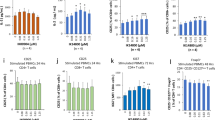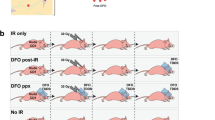Abstract
Direct intralesional injection of DNA encoding interferon-α2 (IFN-α2) was used in an effort to sustain local protein delivery for the treatment of human basal cell carcinoma (BCC). A novel model to study this malignancy was established by transplantation of human BCC tissue on to immunodeficient mice with a relatively high rate of engraftment and stable phenotype for superficial BCC (20 of 25; 80%). Gene transfer was significantly increased by using DNA liposome complexes (lipoplexes). Recombinant gene expression was detected predominantly in the epidermis and, to a lesser extent, in the dermis. Gene transfer of IFN-α2 using this method resulted in sustained production of IFN-α2 protein and increased expression of a known IFN-inducible gene, the class II major histocompatibility (MHC) antigen, and induced BCC regression, presumably through a non-immune mechanism. Intralesional injection of DNA lipoplexes encoding IFN-α protein may therefore be applicable to the treatment of cutaneous BCC.
This is a preview of subscription content, access via your institution
Access options
Subscribe to this journal
Receive 12 print issues and online access
$259.00 per year
only $21.58 per issue
Buy this article
- Purchase on Springer Link
- Instant access to full article PDF
Prices may be subject to local taxes which are calculated during checkout





Similar content being viewed by others
References
Miller DL, Weinstock MA . Nonmelanoma skin cancer in the United States: incidence J Am Acad Dermatol 1999 30: 774–778
Buechner SA . Intralesional interferon alfa-2b in the treatment of basal cell carcinoma: immunohistochemical study on cellular immune reaction leading to tumor regression J Am Acad Dermatol 1991 24: 731–734
Cornell RC et al. Intralesional interferon therapy for basal cell carcinoma J Am Acad Dermatol 1990 23: 694–700
Greenway HT et al. Treatment of basal cell carcinoma with intralesional interferon J Am Acad Dermatol 1986 15: 437–443
Grob JJ, Collet AM, Munoz MH, Bonerandi JJ . Treatment of large basal-cell carcinomas with intralesional interferon-alpha-2a Lancet 1988 1: 878–879
Hunt MJ et al. Regression in basal cell carcinoma: an immunohistochemical analysis Br J Dermatol 1994 130: 1–8
Thestrup-Pedersen K, Jacobsen IE, Frentz G . Intralesional interferon-alpha 2b treatment of basal cell carcinoma Acta Derm Venereol 1990 70: 512–514
Wickramasinghe L, Hindson TC, Wacks H . Treatment of neoplastic skin lesions with intralesional interferon J Am Acad Dermatol 1989 20: 71–74
Chimenti S et al. Use of recombinant interferon alfa-2b in the treatment of basal cell carcinoma Dermatology 1995 190: 214–217
Dellon AL, Elfenbein GJ, Orlando JC . Impairment of thymus-derived lymphoid cell function in patients with basal cell carcinoma J Surg Oncol 1984 25: 92–97
Murphy GF, Krusinski PA, Myzak LA, Ershler WB . Local immune response in basal cell carcinoma: characterization by transmission electron microscopy and monoclonal anti-T6 antibody J Am Acad Dermatol 1983 8: 477–485
Myskowski PL, Safai B, Good RA . Decreased lymphocyte blastogenic responses in patients with multiple basal cell carcinoma J Am Acad Dermatol 1981 4: 711–714
Meissner K et al. Quantitative analysis of T6-positive Langerhans cells in human skin cancers Virchows Arch 1986 410: 57–63
Knop J . Immunologic effects of interferon J Invest Dermatol 1990 95: 72S–74S
Mozzanica N et al. Immunohistological evaluation of basal cell carcinoma immunoinfiltrate during intralesional treatment with alpha 2-interferon Arch Dermatol Res 1990 282: 311–317
Buechner SA et al. Regression of basal cell carcinoma by intralesional interferon-alpha treatment is mediated by CD95 (Apo-1/Fas)-CD95 ligand-induced suicide J Clin Invest 1997 100: 2691–2696
Nabel GJ et al. Immune response in human melanoma after transfer of an allogeneic class I major histocompatibility complex gene with DNA–liposome complexes Proc Natl Acad Sci USA 1996 93: 15388–15393
Nabel GJ et al. Direct gene transfer with DNA–liposome complexes in melanoma: expression, biologic activity, and lack of toxicity in humans Proc Natl Acad Sci USA 1993 90: 11307–11311
Nabel GJ et al. Direct gene transfer for treatment of human cancer. In: Liu MA, Hilleman MR, Kurth R (eds) . DNA Vaccines: A New Era in Vaccinology New York Academy of Sciences: New York 1995 227–231
Stephan DJ et al. A new cationic liposome DNA complex enhances the efficiency of arterial gene transfer in vivo Hum Gene Ther 1996 7: 1803–1812
Pawlowski A, Haberman HF . Heterotransplantation of human basal cell carcinomas in ‘nude’ mice J Invest Dermatol 1979 72: 310–313
Grimwood RE et al. Transplantation of human basal cell carcinomas to athymic mice Cancer 1985 56: 519–523
Grimwood RE, Tharp MD . Growth of human basal cell carcinomas transplanted to C57/Balb/C bgJbgJ-nu/nu (beige-nude) mice J Dermatol Surg Oncol 1991 17: 661–666
Gutterman JU . Cytokine therapeutics: lessons from interferon alpha Proc Natl Acad Sci USA 1994 91: 1198–1205
Pestka S, Langer JA, Zoon KC, Samuel CE . Interferons and their actions Annu Rev Biochem 1987 56: 727–777
Pfeffer LM et al. Biological properties of recombinant alpha-interferons: 40th anniversary of the discovery of interferons Cancer Res 1998 58: 2489–2499
Horton HM et al. A gene therapy for cancer using i.m. injection of plasmid DNA encoding interferon-a Proc Natl Acad Sci USA 1999 96: 1553–1558
San H et al. Safety and short-term toxicity of a novel cationic lipid formulation for human gene therapy Hum Gene Ther 1993 4: 781–788
Sambrook J, Fritch EF, Maniatis T . Molecular Cloning: A Laboratory Manual Cold Spring Laboratory Harbor Press: Cold Spring Harbor, NY 1989
Leung K, Nabel GJ . HTLV-I transactivator induces interleukin-2 receptor expression through an NF-kB-like factor Nature 1988 333: 776–778
Manthorpe M et al. Gene therapy by intramuscular injection of plasmid DNA: studies on firefly luciferase gene expression in mice Hum Gene Ther 1993 4: 419–431
Michael G . Nitroblue tetrazolium chloride (NBT). In: Bergmeyer V (ed) . Methods of Enzymatic Analysis, 3rd edn Academic Press: New York 1983 197–232
Yokota T, Reeves AG, MacLean PD . Intracellular olfactory response of hippocampal neurons in awake, sitting squirrel monkeys Science 1967 157: 1072–1074
Acknowledgements
We thank Ms Nancy Barrett and Ms Donna Gschwend for manuscript preparation and other members of the Nabel laboratory for their helpful advice and comments, and Jon Norman and colleagues at Vical for kindly providing DMRIE/DOPE. MOH is supported by the Commission for the Advancement of Young Scientists and Scholars of the University of Zurich, Switzerland. This work was supported in part by a grant from the National Institutes of Health (1 P01 CA59327).
Author information
Authors and Affiliations
Rights and permissions
About this article
Cite this article
Hottiger, M., Dam, T., Nickoloff, B. et al. Liposome-mediated gene transfer into human basal cell carcinoma. Gene Ther 6, 1929–1935 (1999). https://doi.org/10.1038/sj.gt.3301036
Received:
Accepted:
Published:
Issue Date:
DOI: https://doi.org/10.1038/sj.gt.3301036
Keywords
This article is cited by
-
Intratumoral interferon-α gene transfer enhances tumor immunity after allogeneic hematopoietic stem cell transplantation
Cancer Immunology, Immunotherapy (2009)
-
Adenovirus-mediated interferon α gene transfer induces regional direct cytotoxicity and possible systemic immunity against pancreatic cancer
British Journal of Cancer (2005)
-
IFNα induces Fas expression and apoptosis in hedgehog pathway activated BCC cells through inhibiting Ras-Erk signaling
Oncogene (2004)
-
Regression of tumors by IFN-α electroporation gene therapy and analysis of the responsible genes by cDNA array
Gene Therapy (2002)
-
Intramuscular electroporation delivery of IFN-α gene therapy for inhibition of tumor growth located at a distant site
Gene Therapy (2001)



